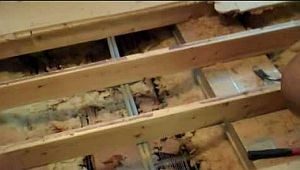 Soft and sagging floors are a common problem in mobile homes in Florida. Soft floors need to be repaired correctly because they compromise the structural integrity of the mobile home and can cause safety hazards. Florida Anchor and Barrier repairs hundreds of mobile home floors all over Florida every year. These are some of the common causes behind soft and sagging floors and how we identify and repair them.
Soft and sagging floors are a common problem in mobile homes in Florida. Soft floors need to be repaired correctly because they compromise the structural integrity of the mobile home and can cause safety hazards. Florida Anchor and Barrier repairs hundreds of mobile home floors all over Florida every year. These are some of the common causes behind soft and sagging floors and how we identify and repair them.
Causes of Soft Floors in Mobile Homes:
Mobile Home Water Damage:
a. Plumbing Leaks: Undetected or unaddressed plumbing leaks can lead to water seepage into the subfloor, causing rot and weakening the floor structure.
b. Moisture Intrusion: Improper sealing around windows, doors, or damaged roofing can allow water to enter the mobile home, leading to floor damage.
Mobile Home Foundation Issues:
a. Settling: Mobile homes may shift or settle over time due to inadequate or unstable foundations, causing stress on the floor and leading to soft spots.
b. Improper Supports: Inadequate or deteriorated support piers, beams, or joists can result in an uneven weight distribution, causing sagging or soft floors.
Insect Infestation:
a. Termites and Wood-Boring Insects: These pests can infiltrate the mobile home’s wooden components, including the floor structure, leading to weakened and softened areas.
Aging and Wear:
a. Deterioration: Over time, the materials used in mobile home construction may degrade, leading to weakened floors.
b. High Foot Traffic: Heavy use or concentrated foot traffic in certain areas of the mobile home can accelerate wear and contribute to soft spots.
Repairing Soft and sagging Floors in Mobile Homes:
Inspection of mobile home floors
a. Identify Soft Areas: Thoroughly inspect the floor for soft spots, sagging, or unevenness to pinpoint the extent of the damage.
b. Remove Floor Coverings: Remove carpets, vinyl, or laminate flooring to expose the damaged subfloor for assessment and repair.
Identify and Mitigate Water Damage In Mobile Home:
a. Fix Plumbing Leaks: Locate and repair any plumbing leaks to prevent further water damage.
b. Dry Out the Affected Areas: Use dehumidifiers or fans to remove moisture from the subfloor and surrounding areas.
c. Replace Damaged Subfloor: Remove and replace the water-damaged sections of the subfloor, ensuring proper support and reinforcement.
Mobile Home Foundation Repairs:
a. Stabilize the Foundation: Consult a professional to address any foundation issues, such as settling or inadequate support. This may involve reinforcing piers, beams, or joists.
- b. Leveling the Floor: Once the foundation is stabilized, use jacks or other lifting mechanisms to gradually lift and level the affected areas.
Mobile Home Insect Infestation Treatment:
a. Exterminate the Infestation: Engage professional pest control services to eliminate termites or wood-boring insects from the mobile home.
b. Replace Damaged Sections: Remove and replace any infested or weakened sections of the floor, ensuring proper treatment and prevention measures.
Mobile Home Floor Repair:
a. Reinforce Joists and Beams: Add additional support by sistering new joists or reinforcing beams to strengthen the floor structure.
b. Install Subfloor Braces: If necessary, install subfloor braces to further reinforce the weakened areas and distribute weight evenly.
c. Install New Subflooring: Replace the removed subfloor sections with new, moisture-resistant materials suitable for mobile home construction.
d. Reinstall Flooring: Once the subfloor is secured and level, reinstall the desired floor coverings.
If you have any problems with floors in your mobile home, call us today and we’ll come out and see you right away. We’ll give you a Free Consultation and a Free Estimate.
